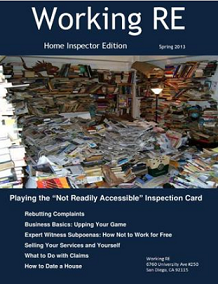 |
>> See Past News Editions >> Follow our NEW Home Inspector RSS Feed >> Click to Print >> Note: If you live in “high-priced” states like AZ, CA, IL, NJ, PA, FL, TX or WA, OREP does not limit coverage or raise your rates. The same rates apply in all states where program is offered. Same day coverage. |
Why Photos are Important to Your Lawyer
By Joseph W. Denneler, Esquire
I have been giving educational seminars and litigating home inspection cases for over fifteen years. A stock part of my presentation always includes a discussion about photographs. I am glad to report that over the years the number of folks who tell me they do not take any photographs during an inspection has decreased.
I would like to take credit for pushing that agenda, but in reality the increase in inspectors taking photographs comes from better, simpler technology, a push by many insurance carriers and risk managers, and the drive to set oneself apart from the competition by providing a better report.
The reasons given for refusing to take photographs during an inspection have not changed much since I started having this dialogue at my seminars. They generally fall into two categories: hassle and fear. The hassle contingent cites the increase in time spent taking the photographs, incorporating them into their reports and maintaining the photographs. The fear group worries about taking photographs of conditions that they fail to identify during the inspection, then having those photographs used against them in a later lawsuit. Neither position trumps the benefits of taking photographs, particularly if you ever find yourself embroiled in litigation over an inspection.
The hassle defense has problems of credibility. Anyone remotely familiar with today’s digital cameras can shoot hundreds of photographs during an inspection without adding significant time to the process. I do appreciate that not all inspectors use some form of computerized report production that would walk them through adding photographs to the report with little trouble. Having the photographs placed within the text of the report adds to the “pop” of the experience for the reader and labeled photographs attached to the end of the report give your client a face-to-face representation of what you are reporting. Storage and preservation of the images are simply not that expensive anymore. Flash drives are cheap and effective for storing photographs without taking up too much space on your hard drive or server. All in all, the hassle defense seems superficial.
The fear group, I must admit, has a more compelling argument. What if, in the course of taking photographs, I shoot something that I fail to report and then my client has evidence to sink me in court? I wish I could write that this fear is totally unfounded, but as with most “I never” statements, there is always a first time. I did have a client who took hundreds of photographs, used some and kept the rest on his PC. Litigation ensued over the sale of the property and the inspector’s file was obtained by subpoena by the attorney for the inspector’s clients. The inspector turned over all of his photographs, including the ones he did not use in the report. There was a condition of the plumbing system he failed to note in his report that was evidence of a material defect. He then became “Defendant Number 4” in the lawsuit. But one occurrence of such a situation does not a trend make. This is an anomaly. The inspector simply did not review his photographs before he wrote and issued the report. Had he taken that simple step he would have noted and reported the condition. In my opinion, it was not the photographs, but a failure to use them, that caused that claim to mushroom.
The benefits of taking and keeping photographs from an inspection far outweigh any of the above arguments. As a defense lawyer, having those photographs is critical. Part of my job is to recreate your experience performing that inspection as best I can. I need to know if the conditions were changed by humans or by time. I need to see the impediments to your ability to discern conditions. Absent such evidence of that moment in time during your inspection, my only evidence comes from the people suing you and what you can remember. The fact is that memories fade over time. Recollections are affected by additional information, life events and the like. It is a function of our limited ability to take true snapshots with our minds. Specifically for home inspectors, you have an average of three to four hours of time at a property. You write your report, and move on to the next job. I hope that most, if not all of you, are so busy that you see a hundred homes or more a year.
(story continues)
Now take into account that most lawsuits are not filed until a year or in some cases several years after your inspection. Can you remember the color of that house? Do you recall what the exterior cladding was, or how many windows were on the front? The answer to these questions is likely no.
If you ever find yourself involved in litigation related to your profession you will likely not be able to remember details about the home involved. Photographs are the great equalizer. Having many digital records of the conditions you saw allows your memory to recall events more clearly. They orient you to which areas were readily accessible, and perhaps more importantly, which were not. They put you on an equal footing with the claimants in terms of being able to intelligently describe the home you inspected in detail.
Perhaps just as important as being your memory aide, photographs preserve the evidence I need to defend your interests. Conditions change. Many times, repairs destroy the physical evidence of the conditions you saw during an inspection. Weather events can cause latent defects to materialize. Attempts at concealment are revealed. All of this can occur in a very short period of time. Despite the best efforts of defense attorneys, not all cases are dismissed when a plaintiff destroys physical evidence. It becomes a decision for a judge. The test is usually whether the defense was significantly prejudiced by being unable to examine the conditions as they existed. A judge can allow a case to proceed where the only remaining evidence of the conditions are photographs taken by the plaintiffs during repairs. Those photographs are not taken with your best interests in mind, and are not taken to preserve the evidence. They are taken to support the claim for damages. In rare cases they are doctored or staged. Having your own photographic record of the conditions eliminates this possibility and ensures that your perspective and limitations in performing the inspection are preserved.
I truly hope you never have to defend your work in court. But if you do, wouldn’t you want to have the very best evidence available? The only way to preserve the conditions you experienced, to preserve your memory of the inspection, and to prevent anyone from changing the conditions is by taking photographs. I assure you, if you do ever end up as a defendant, you will be glad you took the time to protect yourself.
About the Author
Attorney Joe Denneler provides inspection contracts written to the home inspection standards applicable and specific to your state. OREP members enjoy 25 percent off these services (pg. 31). To contact Joe or if you’re an OREP member and would like the discount code, email isaac@orep.org.
Reprinted from National Association of Home Inspectors, Inc. (NAHI) The NAHI Forum Magazine, Winter 2015.


